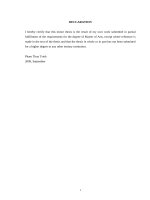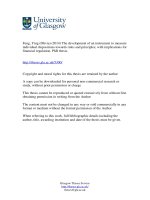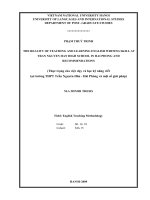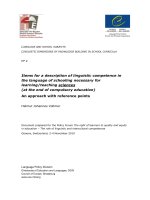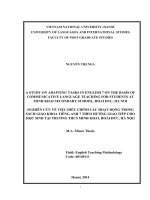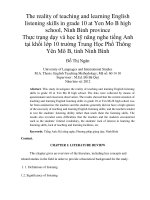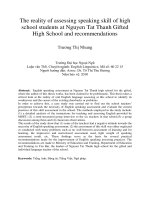The reality of using English in correspondence of staff in Customer Service Department at Hapyc Inc and suggested solutions
Bạn đang xem bản rút gọn của tài liệu. Xem và tải ngay bản đầy đủ của tài liệu tại đây (346.78 KB, 39 trang )
THUONGMAI UNIVERSITY
ENGLISH FACULTY
------
GRADUATION PAPER
A STUDY ON THE REALITY OF USING ENGLISH IN
CORRESPONDENCE OF STAFF IN CUSTOMER SERVICE
DEPARTMENT AT HAPYC INC AND SUGGESTED
SOLUTIONS
Supervisor: MA Duong Thi Hong Tham
Student: Nguyen Khanh Linh
Class: K53N3
Student’s number: 17D170138
HANOI - 2021
ACKNOWLEDGEMENTS
I would like to send my deepest and most sincere gratitude to many people for
their invaluable help during the conduct of the research.
First and foremost, I gratefully acknowledge my deep indebtedness to all
teachers who helped us in this study. Particularly, I wish to express my thanks to
Master Duong Thi Hong Tham who give me step to step instructions and supportive
guidelines during the writing of this paper. My thanks are extended to the Faculty of
English teaching staff at Thuongmai University.
Moreover, I have to acknowledge as well the participation of the staff in
Customer Service Department at Hapyc Inc who have enthusiastically taken part in
the research. My thanks also give to all of our friends at Thuongmai University who
have been the best study partners since the very beginning.
Last but not least, my thank gives to our parents who have been emotionally
and financially supporting us to study English at Thuongmai University. If it was
not because of their help, I would never be here to finish this study.
I sincerely thank you!
Hanoi, April 18th, 2021
Student
Nguyen Khanh Linh
1
ABSTRACT
Business correspondence is considered to be an important skill of learning
writing skills, the importance of writing English in general and English writing
email in particular, so it is very big for people. learn any language. Limitation in
writing can reduce job advancement, limit social interactions, and negatively affect
a writer's assessment of a writer's ability and reputation.
This study investigates the reality of using English in correspondence of staff
in Customer Service Department at Hapyc Inc and suggested solutions. In other
words, to find the difficulties employees have to come through and find ways to
solve these problems. The method used for this research is quantitative. The tools
used for data collection were interviews and structured questionnaires. The
collected data was analyzed both descriptively and artistically.
The purpose of this study is to identify common problems encountered by
Hapyc's customer service staff and provide solutions. Literature review shows that
with careful preparation and integration, writing in business correspondence can
play an important role in supporting learners' overall communication skills
including communication, direct and indirect communication.
TABLE OF CONTENTS
ACKNOWLEDGEMENTS.............................................................................i
ABSTRACT.....................................................................................................ii
TABLE OF CONTENTS...............................................................................iii
LIST OF ABBREVIATIONS.........................................................................v
LIST OF TABLES AND FIGURES................................................................vi
CHAPTER 1: OVERVIEW OF THE STUDY.............................................1
1.1. Rationale of the study............................................................................1
1.2. Previous studies......................................................................................3
1.3. Aims of the study....................................................................................4
1.4. Research subjects...................................................................................5
1.5. Scope of the study..................................................................................5
1.6. Research methodology...........................................................................5
1.7. Organization of the study......................................................................6
CHAPTER 2: LITERATURE REVIEW......................................................7
2.1. Definitions.................................................................................................7
2.1.1. Business correspondence......................................................................7
2.1.2. Emails.....................................................................................................7
2.2. Format of a business correspondence.....................................................7
2.3. Content and style of business correspondence.....................................10
2.3.1. Length...................................................................................................10
2.3.2. Order and Sequence............................................................................12
2.3.3. Planning................................................................................................13
2.3.4. Style and language...............................................................................14
2.3.5. Clarity...................................................................................................15
2.4. Layout of an email..................................................................................17
CHAPTER 3: RESEARCH FINDINGS.....................................................18
3.1. The attitude of staff in CSD in Hapyc Company about writing an
email in English.............................................................................................18
3.1.1. The staff’s frequency in writing English emails at Hapyc............18
3.1.2. The employees’ attitude towards indirect email communication....19
3.1.3. Staff’ attitudes toward the level of difficulty in writing an English
email................................................................................................................19
3.1.4. Staff’ attitudes toward the importance of responding oversea
customers via email.......................................................................................20
3.2. The problems in the process of writing emails in English..................21
3.2.1. Common mistakes in writing English emails....................................21
3.2.2. Common problems in using email.....................................................22
3.3. Suggested some solutions to improve writing English email skill......23
3.4. Interview.................................................................................................24
CHAPTER 4: RECOMMENDATIONS AND SUGGESTIONS..............26
4.1. Limitation of the study and suggestion for further study...................27
4.1.1. Limitation of the study........................................................................27
4.1.2. Suggestion for further study...............................................................27
4.3. Future research recommendations.......................................................28
CONCLUSION..............................................................................................29
REFERENCES..............................................................................................30
APPENDIX....................................................................................................31
LIST OF ABBREVIATIONS
Abbreviation
CSD
Hapyc Inc
English meaning
Customer Service Department
Hapyc Incorporated
Vietnamese meaning
Bộ phận chăm sóc khách hàng
Tập đồn Hapyc
LIST OF TABLES AND FIGURES
LIST OF TABLES
Table 2.2.1: Complementary close following to salutation...............................9
Table 3.2.1. Common problems in using email...............................................22
Table 3.3.1. Staff’s solution to improve writing an English email skill.........23
LIST OF FIGURES
Figure 3.1.1 The staff’s frequency in writing English emails at Hapyc
Figure 3.1.2 The employees’ attitude towards indirect email communication
Figure 3.1.3 The employees’ attitude towards the level of difficulty in writing
an English email
Figure 3.1.4 Staff’ attitudes toward the importance of responding oversea
customers via email.
CHAPTER 1: OVERVIEW OF THE STUDY
1.1. Rationale of the study
The first point is that English is the most widespread language for
communication, which makes it a top choice when deciding what language to study
with different purposes. In history, languages, and especially their popularity, are
largely affected by political and geographic factors, and thus, English has become
the most widespread language in the world. The British and American colonizations
resulted in a large number of the world’s population speaking English as a native
language. According to Salman Rushdie, Imaginary Homelands (Granta Books
1992) “What seems to be happening is that those people who were once colonized
by the language are now rapidly remaking it, domesticating it, becoming more and
more relaxed about the way they use it – assisted by the English language’s
enormous flexibility and size, they are carving out large territories for themselves
within its frontiers.” The United States and the United Kingdom are two of the main
political powers in the world which means that business is thriving there.
Consequently, English has become the main engine for communication in the
business sphere.
In a report of British Council called “The English Effect”, they said “English
is spoken at a useful level by some 1.75 billion people worldwide – that’s one in
every four. By 2020, we forecast that two billion people will be using it – or
learning to use it. And it is the economically active, the thought leaders, the
business decision-makers, the young, the movers and shakers present and future
who are learning and speaking English. They are talking to each other more and
more and English is the ‘operating system’ of that global conversation.” As we can
see that nowadays the language becomes more and more popular because of its
importance to business growth and communication. English is the only language
that has attracted more than one billion learners globally, which is no surprise,
considering the opportunities this language reveals for businesses. Many
international companies have adopted English as the primary language they work
with, even as the origin of these companies is not from an English speaking country.
Some of the most prominent examples of such companies include Nokia (Finland)
and Airbus (France).
1
Another point is the development of electronic commerce which is also known
as electronic commerce or internet commerce. According to The World Trade
Organization (WTO), electronic commerce is “a new area of trade involves goods
crossing borders electronically. Broadly speaking, this is the production,
advertising, sale and distribution of products via telecommunications networks. The
most obvious examples of products distributed electronically are books, music and
videos transmitted down telephone lines or through the Internet.” Since the model
of e-commerce has helped businesses and customers more convenient in the buying
and selling process. In the early days when customers were still unfamiliar with
online purchases, businesses had difficulty in branding and building trust with
online customers. Until now, online shopping has become a habit of a lot of people
because of the convenience it brings.
Along with the trend of technology development in the world, e-commerce in
Vietnam is also gradually forming and growing strongly. According to Eu-Vietnam
Business Network (EVBN), in the report called “E-commerce Industry in Vietnam”
(2018), they showed that “Vietnam is a land of opportunity for foreign E-commerce
companies because of its young population, high Internet penetration rate (ranked
17th in the world) and climbing smartphone penetration rates.” They also forecasted
that the internet penetration will steadily increase, with the share of Internet users
reaching 65% by 2022. According to statistics of Vietnam Finance Magazine
(2021), Vietnam is considered one of the fastest growing e-commerce markets in
Southeast Asia, following to Indonesia. With high and continuous growth from
2015 onwards, it is forecasted that by 2020, the size of Vietnam's e-commerce
market may reach 13 billion USD.
Founded in 2016, although not a large-scale enterprise, Hapyc Inc always
strives to develop e-commerce, the main market is the US. English is one of the
essential requirements for a candidate in the marketing and customer service
department. In fact, during the internship as an employee of the Customer Service
Department, the researcher found that taking care of international customers via
email is very effective and brings many benefits to the company. However, for
Vietnamese businesses in general and Hapyc's customer service staff in particular,
the use of English is not flexible and accurate, especially email writing skills.
Stemming from the reality and difficulty in writing emails by English of
2
Vietnamese people in general and of Hapyc's customer service staff in particular,
the researcher would like to conduct a study on “The reality of using English in
correspondence of staff in Customer Service Department at Hapyc Inc and
suggested solutions”. All previous studies not only are immensely helpful for the
researcher but also gave the researcher inspiration to consider the study.
1.2. Previous studies
There has not been much research on written emails in Customer Service
Department of a company. However, the following research studies were found to
be related to international companies. According to Gabriela (2008), “Emails should
not use the passive voice because the sentences will be vague and impersonal. On
the other hand, the use of active voice is direct, concise and authoritative. It is also
more natural sounding than passive voice.” Moreover, according to Ann Raine
Thomson, in the study “Writing Effective Business Letters”, the author said “Good
business letters open doors and promote business. Poor business letters can close
doors fast” and he showed how to write a letter well. Another study called
“Problems In Writing English Business Emails of Non-Native Speaking Employees
in An International Real Estate Service Company in Thailand” written by Patitta
Malathong is really useful for the researcher, it showed the problems in writing
business emails of people who speak English like the second language in an
international company. In the study “Analyzing Genre: Language Use In
Professional Settings”, (1993a, p.51) Bhatia used a genre approach, analyzing quite
in detail about English business discourse. In addition, he also came up with a 7step voice model for English sales and cover letters. Henry and Roseberry (2001,
p.94), while studying Anglo-American commercial correspondence, have also
presented a 14-step voice model in cover letters. Maier (1992, p.67) examines the
differences in correspondence between native speakers and non-native speakers,
mainly Eastern students (China, Thailand, and Korea).
In Vietnam, the research on commercial correspondence is not much, however,
some studies below contribute to help the author's research to be more complete.
The author Nguyễn Xuân Thơm (2001), in his doctoral thesis on linguistic elements
in international trade negotiations called “Các Yếu Tố Ngôn Ngữ Trong Đàm Phán
Thương Mại Quốc Tế”, compared to the analysis of linguistic characteristics in the
3
English language and language. Vietnamese in international trade negotiations.
Regarding the discourse of commercial correspondence, two authors have analyzed
the discourse of this type of document, that is Nguyễn Trọng Đàn (1996), in his
doctoral thesis called “Phân Tích Diễn Ngơn Thư Tín Thương Mại” has analyzed
and collated a number of linguistic characteristics between English and Vietnamese
correspondence. The author Trịnh Ngọc Thanh in the doctoral thesis called “Đối
Chiếu Văn Bản Thư Tín Thương Mại Tiếng Anh Với Tiếng Việt” has pointed out
the characteristics of the form and content of some types of English commercial
correspondence documents.
All these studies not only helped the researcher with precious knowledge but
also inspired the researcher to conduct a study on “The reality of using English in
correspondence of staff in Customer Service Department at Hapyc Inc and
suggested solutions ” which aimed to gain more knowledge, seeking out difficulties
and suggesting some solutions to improve staff’s writing email skill.
1.3. Aims of the study
It can be said that objective of the research is one of the most important parts,
this is considered as guidelines for researcher to find out the right direction. A clear
research objective will not only help the researcher but also the reader to solve the
research problem. Comprehending and grasping the importance of the study aims,
the researcher defined three main objectives.
First of all, the researcher points out the customer service staff's attitude
towards writing emails in English, specifically via Gmail. Since then, the researcher
has assessed the importance of English in indirect communication with foreigners
and at the same time understands the meaning of taking care of foreign customers
via email.
Secondly, research paper shows some problems in the process of writing email
in English. In fact, the way of writing letters of Vietnamese people and foreigners,
specifically Americans is quite different, so in the process of writing letters to
American customers, employees at Hapyc also encounter many problems not only
in appearance but also in the content of the letter.
Last but not least, the study is to provide several solutions to improve email
writing skills. These solutions may not be the most optimal, but they help research
4
subjects and readers to improve their writing English skills, especially English
email writing skills.
1.4. Research subjects
It cannot be denied that there are many businesses in Vietnam using English as
a tool for development and expansion, Hapyc Inc is also one of them. There are
many Vietnamese qualified to access English, but not all of them are fluent in
English, in fact working at Hapyc, most of the staff of the customer service
department are graduated students and they have approached English in many
different ways, which leads to different problems encountered in writing emails in
English. This study is a significant study with high practicality. The researcher
examines the major mistakes and give some solutions not only for the staff but also
for those who need to improve their writing email skill.
1.5. Scope of the study
This study is researched to point out the current situation of using English by
staff in Hapyc's Customer Service Department in writing emails and offering
specific solutions to solve the problems.
Firstly, due to the researcher’s time and experience constraints, other areas
such as structure and vocabulary in writing skill or the causes of the problems are
not mentioned in depth. The researcher just focus on writing an English email skill.
Secondly, because of the limitation in time, budget, facilities and experience,
the study paid main attention to the 19 major employees in Hapyc company.
1.6. Research methodology
The study was carried out with a survey research design. Questionnaire and
interview were two methods that were chosen to conduct this study. The first
instrument is a questionnaire consisting of four parts.
The first part referred to personal information, the researcher gives them some
question like: “How long have you been learning English?”, “What do you use
English for?”.
The second part of the questionnaire are questions to investigate current
situation and attitude of subjects about writing an email in English, for instance,
“How often do you write an email?”, “Do you like to communicate indirectly by
email?”, “Do you think writing an email in English is difficult?”, “Do you think it's
5
really necessary to give customers responses through email?”. The researcher used a
4-point Likert scale, from A to D following arrangement “Really like, like, neutral
and dislike” to discover the respondents’ attitudes toward writing English email
skill.
Part three included questions which aimed to answer the question “What are
the problems in the process of writing emails in English?”. The researcher lists
some issues about writing an English email and using email ang give some
questions such as “Do you think it is difficult in spelling words correctly?”, “Is this
difficult in using correct punctuation” and so on.
The last part of the survey is about the solutions to improve writing email skill
in English. It includes several useful methods not only for the employees but also
for students.
The quantitative data gained from three parts of the questionnaire were
calculated and transferred into numerical form concerning the items’ percentage of
participants who share similar answers.
1.7. Organization of the study
The study consists of four main chapters:
Chapter One, Overview of the study, provides an overview of the study in
which the reasons for choosing the study was presented. It also includes the aims of
the study, research subject, the scope of the study, research methodology and the
organization of the study.
Chapter Two, Literature review, provides the theoretical background for the
thesis. There are four main parts in this chapter, including the definitions and the
format, content and style of English business correspondence and the layout of an
email.
Chapter Three, Research findings, aims to describe the backdrop information
about the reality of staff in Customer Service Department at Hapyc Inc and
suggested solutions. Detailed data analysis and discussions are also given.
The Last Chapter, recommendations and suggestions are given for further studies.
6
CHAPTER 2: LITERATURE REVIEW
This chapter presents an overview of the document, ensuring adequate
knowledge of the definitions of business correspondence and email. Moreover, it
shows the format, structure and the characteristics of a commercial email document,
and how to write a complete email.
2.1. Definitions
2.1.1. Business correspondence
According to the book called “Merriam-Webster's guide to business
correspondence” (1993), business correspondence means “the exchange of
information in a written format for the process of business activities. Business
correspondence can take place between organizations, within organizations or
between the customers and the organization. The correspondence refers to the
written communication between persons. Hence oral communication or face to face
communication is not a business correspondence”.
2.1.2. Emails
E-mail or Electronic Mailbox (email or e-mail) is “a method of exchanging
messages between users of electronic devices. E-mail was first introduced into
limited use in the 1960s and by the mid-1970s took what is today called email. Email works through computer networks, mainly the Internet today. Some early email
systems required the sender and receiver to be both online at the same time, just like
instant messaging. Today's email systems are based on a save and forward model.
Email servers accept, forward, deliver, and store messages. The user or their
computer is not required to be online at the same time; they need to connect in a
moment, usually to an email server or to a web-based email interface as long as
there is a sending or receiving function”.
2.2. Format of a business correspondence
Based on 2 main resources are “Oxford Handbook of Commercial
Correspondence” written by the author A.Ashley and the textbook called “Business
Correspondence” of Thuongmai University, below are 12 difference parts of a
business correspondence.
7
Heading
The heading of a business letter usually contains the name and postal address
of the business, e-mail address, website address, telephone number, fax number,
trade mark or logo of the business (if any)
Date
The date is normally written on the right hand side corner after the heading as
the day, month and years. Some examples are 28th Feb, 2005 or Feb.28, 2005.
Reference
It indicates letter number and the department from where the letter is being
sent and the year. It helps in future reference. This reference number is given on the
left hand corner after the heading.
E.g. AB/FADept./2005/29.
Inside address
This includes the name and full address of the person or the form to whom the
letter is to be sent. This is written on the left hand side of the sheet below the
reference number. Letters should be addressed to the responsible head.
E.g.
The Chief Manager,
State Bank of India
Utkal University Campus
Bhubaneswar,
Orissa - 751007
Subject
It is a statement in brief, that indicates the matter to which the letter relates. It
attracts the attention of the receiver immediately and helps him to know quickly
what the letter is about.
E.g. Subject: Enquiry about Samsung conditioner
Salutation
This is placed below the inside address. It is usually followed by a comma (,).
Various forms of salutation are:
Sir/Madam: For official and formal correspondence
8
Dear Sir/Madam: For addressing an individual
Dear Sirs/Dear Madam: For addressing a firm or company
Body
This comes after salutation. This is the main part of the letter and it contains
the actual message of the sender. It is divided into three parts:
-
Opening part: it is the introductory part of the letter. In this part, attention
of the reader should be drawn to the previous correspondence, if any.
-
Main part: this part usually contains the subject matter of the letter. It
should be precise and written in clear words.
-
Concluding part: it contains a statement of the sender’s intentions, hopes
or expectations concerning the next step to be taken. Further, the sender should
always look forward to getting a positive response. At the end, terms like “thank
you”, “with regards”, “with warm regards” may be used.
Complimentary close
It is merely a polite way of ending a letter. It must be in accordance with the
salutation.
Title
Mr
Mrs
Miss
Ms
Sir
Madam
Sir/Madam
Medical/academic/militar
y
Status
Married or unmarried male
Married female
Unmarried female
Married or unmarried female
Male-name not known
Female-name not known
When unsure whether you are
Complimentary close
Yours sincerely
Yours sincerely
Yours sincerely
Yours sincerely
Yours faithfully
Yours faithfully
Yours faithfully
addressing male or female
These titles do not change Yours sincerely
whether addressing a male or
e.g. Dr/Professor/General female
Table 2.2.1: Complementary close following to salutation
(Source: Oxford Handbook of Commercial Correspondence, p.11)
Signature
It is written in ink, immediately below the complimentary close. As far as
possible, the signature should be legible. The name of the writer should be typed
9
immediately below the signature. The designation is given below the type name.
where no letterhead is in use, the name of the company could be included below the
designation of the writer.
E.g.
Yours faithfully
For M/S Acron Electricals
(Signature)
SUNIL KUMAR
Partner
Enclosures
This is required when some documents like cheque, draft, bills, receipts, lists,
invoices etc. are attached with the letter. These enclosures are listed one by one in
serial numbers.
Copy circulation
This is required when copies of the letter are also sent to persons apart of the
addresses. It is denoted as C.C
Post script
This is required when the writer wants to add something, which is not included
in the body of the letter. It is expressed as P.S
2.3. Content and style of business correspondence
Oxford Handbook of Commercial Correspondence illustrates that there are 6
main contents in a business correspondence, each content contains some styles.
2.3.1. Length
The writer needs to consider the amount of information transmitted through
the mail that is sufficiently balanced and reasonable for the recipient to understand.
The style of writing as well as the language used will influence the length of the
letter. Some letters below are examples for three styles of this content.
Too long:
Dear Mr. Smith,
Thank you very much for your request on March 2 that we received today. We
10
receive a lot of requests from many potential customers, especially right now the
stores are full of gifts for Mother's Day on May 9.
We've included our souvenir catalog and are sure to be impressed by our wide
range of T-shirts. You will find that they include models for women of all ages at
prices that are right for all of your customers. In addition, we also have a return
policy, for any returned product that the fault belongs to our company, we will send
you the product as soon as possible, and give you a discount of 10 % of the total
number of defective rows.
Along with that, you will also find our pricelist that provides full details on
prices to California (including costs, insurance and rates) and explains our offers for
loyal customers like you. We think you'll be so excited and we hope you get the
most out of it.
We are always ready to provide you with more information of our products
and are capable of giving you special attention whenever you ask. As you can see,
we deal with a lot of stores in countries from the Far East to Europe, this alone
speaks to our reputation, in line with our company motto "Always Leading The
Trend".
Once again, thank you for your inquiry and we'd say we look forward to
hearing from you in the future.
Best regards,
There are some things wrong with this letter. Although the writer tried to
advertise the company's products and strengths, it was too wordy. There's no need to
explain that the stores are making Mother's day purchases - Mr. Smith knows this.
Instead of drawing attention to the company's T-shirts and other items, the writer
talked about the company's history, the thing Mr. Smith was not interested in.
Too short:
Dear Sir,
Thank you for your enquiry. We have a wide collection of T-shirts which we
are sure that you will like. We will be sending a catalogue soon.
Yours faithfully,
This letter is too short, it has some mistakes:
11
- It should have begun with “Dear Mr. Smith” because the writer knew his
name when receiving his inquiry.
- It should show more details about the product including the pricelist and
incentive.
The right length:
Dear Mr. Smith,
Thank you for your inquiry on March 2.
We enclose a catalog and a pricelist providing details of the CIF California
price, discount and delivery date.
While you will find we offer a lot of souvenirs, we can draw your attention
from page 5 to 8 where the products could match your description.
All of our products have return policy and are backed by our worldwide
reputation.
If you need any further information, please feel free to contact us. We look
forward to hearing from you soon.
Yours sincerely,
2.3.2. Order and Sequence
In addition to the requirement of length, order and sequence is also important.
The information in the following paragraph must be connected to the previous
paragraph instead of repeating it.
Unclear sequence:
Dear Sir / Madam,
We are very interested in your company's collection of posters. We would like
to know more information about the prices and offers of each product.
One store used your painting for wall hanging and they showed me your
company's catalog. We are very impressed with the pictures of food and do not
know if your company accepts pictures on request.
In your catalog, we found that the products on page 8 match our requirements
very well. In addition, we also want to order to print some samples not in the
catalog, we want to ask you more about printing service on request. If so, we will
send you the mockup and design which we want to print.
12
If you offer competitive prices, I will order in bulk to decorate all of our
stores.
We would like to make a decision on this soon, so we would appreciate an
early reply.
Yours faithfully,
This letter has no clear sequence and logical order.
Clear sequence:
Dear Mr. John,
We are a chain of retail stores looking for large quantities of posters. We were
referred to by a friend, whom you just delivered last week.
We need a lot of paintings to decorate the store. I see in the catalog, the
products on page 8 fit our requirements well.
However, it is very helpful to have your company printed poster on request,
we will order 500 posters.
Of course, our choices will be affected by competitive price and full guarantee
of related services.
Please respond as soon as possible as we want to make a decision within the
next few weeks.
Yours sincerely,
It is a better version of the same letter in which the ideas and information are
in a logical order.
2.3.3. Planning
Making a plan to make sure your content is full of the information you want to
cover.
First paragraph: The opening sentence or the opening paragraph is very
important, it determines the tone of the whole letter.
E.g.
Thank you for your inquiry on March 2.
We enclose a catalog and a pricelist providing details of the CIF California
price, discount and delivery date.
Middle paragraphs: This is the most important paragraph, it contains
13
questions you need to ask or answers. Make a plan to ensure that your problems are
not missing or duplicated.
Final paragraph: At the end of the message, if it's a reply, thank the sender
for sending the letter to you. If it is a request, emphasize that you look forward to
hearing from the recipient.
2.3.4. Style and language
Simplicity: The language of a letter dealing in international trade should
be kept simple and easy to understand for the recipient to use too high academic
language.
E.g. This is a letter with complex and unclear message.
Dear Sir / Madam,
We are pleased to inform you that we have received your request for a refund
for the product you ordered at the end of March.
We sincerely apologize for not returning your item as requested, 1 week after
placing your order. We hope you understand for the printer malfunction, so the
product has not been completed yet to send to you soon.
According to the company's policy, if the product has not been delivered for
more than 1 month, we accept a refund to the customer. The product you ordered is
priced at $ 26 and we'll refund the money.
We apologize for any inconvenience and hope you can accept our apology ....
The letter above does not specify the $ 26 refund issue to the guest, but only
explains the reason. Below is a simple letter that solves the problem of the client
request.
Dear Mr. Robert,
I am replying to your letter sent on April 30th about refunds.
I'm sorry for keeping you waiting for a long time. Due to printer damage, we
are unable to deliver to you on time. Under the company's refund policy, I will
refund you $ 26.
Attached below is the payment information. I hope you accept our apology for
any inconvenience.
Yours sincerely,
14
Idioms and colloquial language: In your business correspondence, use
neutral language that shouldn't be too exaggerated or informal.
E.g.
Inappropriate form
Preferred alternative
You’re probably guessed
You are probably aware
You’ll get your money back
The loan will be repaid
Prices are at rock bottom
Prices are very low
Prices have gone through the roof
Prices have increased rapidly
(Source: Oxford Handbook of Commercial Correspondence, p.33)
2.3.5. Clarity
Any type of correspondence in general and business English correspondence
in particular need to ensure the clarity of the content. The errors that cause
confusion for the letter are often caused by the following reasons:
Acronym:
Abbreviations should only be used when there is agreement between both
sides; or it is common acronyms (eg: CIF, FOB; global organizations such as EU,
countries in the world like UK, ...)
Numbers:
-
Numerical interpretations can be confusing. For example, to interpret
decimals, Americans and Britons use dots, and Europeans use commas. For
example, for the number expressing the meaning of "twenty four point seven
hundred two two", an Englishman and an American would write 24,722 and a
European would write 24,722 (but this number means "two four thousand seven
hundred two two "for British or American)
-
Able to write both letters and numbers to avoid confusion. Example
10,995.50 (ten thousand nine hundred and ninety-five pounds fifty pence)
Preposition:
Each preposition used in a sentence has its own meaning. Therefore, if the
writer does not pay attention, the recipient of the message may misunderstand the
conveyed content.
For example, in the following three sentences, there is a huge difference:
-
The price has been increased to 50 USD (Price increased to 50 USD)
15
-
The price has been increased by 50 USD (Price increased to about 50
USD)
-
The price has been increased from 50 USD (Price increased from 50 USD)
2.3.6. Accuracy
Spelling mistakes:
The writer should remember to check for spelling errors before sending the
message. Spelling mistakes can be small, but will give the reader a bad impression
of the writer himself and the company they represent. The writer can re-read it
many times before sending, or send it to others to read before sending the official
letter to avoid unnecessary mistakes. Besides, using automatic spell checking tools
will help users limit errors.
Name, title, address:
Write exactly name, address, title. If the writer does not know the sender's
name, he should not subject Dear Sir or Dear Madam, but should fully write Dear
Sir / Madam. Or if the writer knows the recipient's name and doesn't know their
gender, it's best to write Dear Mr / Ms + name.
Price, unit of measure:
Writer needs clarity, accuracy and transparency in referring to prices or units
of measure in commercial correspondence, especially in quotes / orders. The lack of
clarity in this stage will cause considerable damage.
For example in the sales letter:
Commodity: Trouser suits sizes 8-16 in white, yellow, read. Sizes 14 - 16 in
pink. 2650 per 100 units (the number 2650 indicates the price for 100 items but the
writer forgot to mention the currency, for example USD, pound, ...)
Attachments:
The writer should check before sending has fully attached the documents to
the letter and at the same time, check whether the document is correct with the
content of the letter.
2.4. Layout of an email
Correspondence includes basic forms such as memo, email, letter, fax, etc.
However, as mentioned in section 1.5, the scope of the study is a Customer Service
Department in a small and medium-sized company, in fact showing that the only
16
form they use is email. Below is the layout of a basic email, all information is
selected and based on Oxford Handbook of Commercial Correspondence.
2.4.1. Header information
To: Receiver (E.g. Mr. John, Vinamilk Ltd, …)
Bcc: It’s stands for blind carbon copies. Even though you are sending
content to many people at the same time, no one can see each other. Therefore, you
should use BCC in case you need to protect the identity of others.
Cc: It’s stands for carbon copies. When using CC, all recipients of a
message see a list of emails for everyone who also received the message. That is
why you can use the CC feature to send messages to many members in the same
class or to the same group. It is publicly visible and there is no need to secure
identity or information.
Subject: This is the main subject of the email. In this section, you need to
write briefly, even though the recipient has not seen the details of the letter, he can
see what you want to talk about.
2.4.2. Message text
This section covers the full range of features of the content of a business
correspondence as discussed in section 2.2
2.4.3. Signature
You can create an electronic signature and add the sender's personal
information as well as fax and telephone number.
17
CHAPTER 3: RESEARCH FINDINGS
In the current chapter, all data collected from the questionnaire, the interview
and 19 emails written by the staff were analyzed and discussed to provide answers
for all research questions.
3.1. The attitude of staff in CSD in Hapyc Company about writing an
email in English
3.1.1.
The staff’s frequency in writing English emails at Hapyc
The staff ’s frequency in writing English emails at Hapyc
15.78%
10.52%
26.30%
Seldom
Sometimes
Often
Always
47.40%
Figure 3.1.1 The staff’s frequency in writing English emails at Hapyc
The pie chart above shows that the number of staff who “sometimes” writes
English email is 5 people accounting for 26.3% while 47.4% of people in CSD said
that they “often” practice writing email. This data is twice as the previous one.
Participants who seldom spend time writing English business email reaching the
lowest level in the chart makes up 10.52% of the total number of participants. The
number of people who “always” write emails increased slightly compared to those
who rarely write emails, accounting for 15.78%. The above figure confirms that all
the participants had an interest in writing emails in English, which is a good sign for
the researcher to continue with the survey.
18


